The Influence of FY-4A High-Frequency LST Data on Data Assimilation in a Climate Model
Abstract
1. Introduction
2. Data
2.1. Forcing Data
2.2. Observation Data
2.3. Verification Data
3. Model, Assimilation Algorithm, and Experimental Design
3.1. Land Surface Model
3.2. Assimilation Algorithm
3.3. Experimental Design
4. Results and Analysis
4.1. Spatial Distribution of Annual-Mean LST
4.2. Spatial Distribution of Bias
4.3. Spatial Distribution of Time Correction
4.4. Spatial Distribution of RMSE
4.5. Probability Density Function (PDF) Distribution
5. Conclusions
- The LST simulations of the BCC_AVIM2.0 model are lower than those of the MODIS LST products for both daytime and nighttime periods. The BCC_AVIM2.0 model significantly underestimates the LST over western China at both daytime and nighttime and overestimates it over the Indian peninsula at daytime. When the time frequency of FY-4A LST is 3 h, the ASS 3 h experiments show less biases than that of the CTL experiments at both daytime and nighttime. The biases of experiments with time intervals more than 6 h at daytime and more than 12 h at nighttime are worse than that of the CTL experiments. These large biases are due to insufficient time representativeness of the FY-4A LST data in the assimilation processes. Moreover, when the time frequency of the FY-4A LST observations is reduced to 6 h for the daytime data and 12 h for the nighttime data, the impact of diurnal variation on the simulated LST statement will significantly exceed the positive impact from assimilating FY-4A LST observations, which can even change the overall bias pattern of the LST after assimilation.
- The RMSE of the CTL experiment and the assimilation experiments at nighttime is smaller than the corresponding experiments at daytime. The time frequency of the FY-4A LST observations can also have a significant impact on the RMSE of the assimilation experiments. With the decrease in the time frequency of assimilated FY-4A LST data, the RMSE showed an overall increasing trend at both daytime and nighttime. At nighttime, the RMSE of the assimilation experiments with time frequencies shorter than 12 h is smaller than that of the CTL experiment, while only the assimilation experiment with 3 h time frequency has a smaller RMSE than the CTL experiment. The increase in the RMSE with increasing time frequency of assimilated observation is mainly due to the system bias resulting from reduced observation time information in the FY-4A LST data.
- In semi-arid regions where the daily variability of LST is less affected by precipitation, the CTL experiment and assimilation experiments have better temporal consistency (the time correction coefficient larger than 0.9) with the MODIS data at both daytime and nighttime. When the frequency of the assimilated FY-4A observations was reduced, the regional average correlation coefficients also decreased. After completely ignoring the diurnal variation information of LST, the ASS 24 h experiment results were even worse than that of the CTL experiments. The ASS 24 h result of the nighttime is better than that of the daytime, indicating that the diurnal variation information of LST at daytime has a larger impact on the assimilation than that at nighttime. The diurnal variation information also has an impact on the PDF distribution of the LST. The ASS 3 h experiments have sharper PDF distribution curves for RMSE than the assimilation experiments with longer LST observation frequencies. When the time frequency of the FY-4A LST observations decreases, the PDF distribution curves of the RMSE gradually shift to the right and become flat.
Author Contributions
Funding
Acknowledgments
Conflicts of Interest
References
- Fuchs, M. Infrared measurement of canopy temperature and detection of plant water stress. Theor. Appl. Climatol. 1990, 42, 253–261. [Google Scholar] [CrossRef]
- Kustas, W.; Anderson, M. Advances in thermal infrared remote sensing for land surface modeling. Agric. For. Meteor. 2009, 149, 2071–2081. [Google Scholar] [CrossRef]
- Li, Z.L.; Tang, S.H.; Wu, H.; Ren, H.; Yan, G.; Wan, Z.; Trigo, I.F.; Sobrino, J.A. Satellite-derived land surface temperature: Current status and perspectives. Remote Sens. Environ. 2013, 131, 14–37. [Google Scholar] [CrossRef]
- Ghent, D.; Kaduk, J.; Remedios, J.; Ardö, J.; Balzter, H. Assimilation of land surface temperature into the land surface model JULES with an ensemble Kalman filter. J. Geophys. Res. 2010, 115, D19112. [Google Scholar] [CrossRef]
- Smith, D.; Mutlow, C.; Delderfield, J.; Watkins, B.; Mason, G. ATSR infrared radiometric calibration and in-orbit performance. Remote Sens. Environ. 2012, 116, 4–16. [Google Scholar] [CrossRef]
- Wan, Z. New refinements and validation of the collection-6 MODIS land-surface temperature/emissivity product. Remote Sens. Environ. 2014, 140, 36–45. [Google Scholar] [CrossRef]
- Muster, S.; Langer, M.; Abnizova, A.; Young, K.L.; Boike, J. Spatio-temporal sensitivity of MODIS land surface temperature anomalies indicates high potential for large-scale land cover change detection in Arctic permafrost landscapes. Remote Sens. Environ. 2015, 168, 1–12. [Google Scholar] [CrossRef]
- Norouzi, M.T.; AghaKouchak, A.; Azarderakhsh, M.; Khanbilvardi, R.; Shields, G.; Tesfagiorgis, K. Inferring land surface parameters from the diurnal variability of microwave and infrared temperatures. Phys. Chem. Earth 2015, 83–84, 28–35. [Google Scholar] [CrossRef]
- Didari, S.; Norouzi, H.; Zand-Parsa, S.; Khanbilvardi, R. Estimation of daily minimum land surface air temperature using MODIS data in southern Iran. Theor. Appl. Climatol. 2017, 130, 1149–1161. [Google Scholar] [CrossRef]
- Xu, B.; Park, T.; Yan, K.; Chen, C.; Zeng, Y.; Song, W.; Yin, G.; Li, J.; Liu, Q.; Knyazikhin, Y.; et al. Analysis of global LAI/FPAR products from VIIRS and MODIS sensors for spatio-temporal consistency and uncertainty from 2012–2016. Forests 2018, 9, 73. [Google Scholar] [CrossRef]
- Aumann, H.H.; Broberg, S.; Manning, E.; Pagano, T. Radiometric stability validation of 17 years of AIRS data using sea surface temperatures. Geophys. Res. Lett. 2019, 46, 12504–12510. [Google Scholar] [CrossRef]
- Akinyemi, F.O.; Ikanyengb, M.; Muro, J. Land cover change effects on land surface temperature trends in an African urbanizing dryland region. City Environ. Interact. 2020, 4, 100029. [Google Scholar] [CrossRef]
- Duan, S.B.; Li, Z.L.; Tang, B.H.; Wu, H.; Tang, R.; Bi, Y.; Zhou, G. Estimation of diurnal cycle of land surface temperature at high temporal and spatial resolution from clear-sky MODIS data. Remote Sens. 2014, 6, 3247–3262. [Google Scholar] [CrossRef]
- Reichle, R.H. Data assimilation methods in the Earth sciences. Adv. Water Resour. 2008, 31, 1411–1418. [Google Scholar] [CrossRef]
- Jiménez-Muñoz, J.C.; Sobrino, J.A.; Skoković, D.; Mattar, C.; Cristóbal, J. Land surface temperature retrieval methods from Landsat-8 thermal infrared sensor data. IEEE Geosci. Remote Sens. Lett. 2014, 11, 1840–1843. [Google Scholar] [CrossRef]
- Hain, C.R.; Anderson, M.C. Estimating morning change in land surface temperature from MODIS day/night observations: Applications for surface energy balance modeling. Geophys. Res. Lett. 2017, 44, 9723–9733. [Google Scholar] [CrossRef]
- Padhee, S.K.; Dutta, S. Spatiotemporal reconstruction of MODIS land surface temperature with the help of GLDAS product using kernel-based nonparametric data assimilation. J. Appl. Remote Sens. 2020, 14, 014520. [Google Scholar] [CrossRef]
- Amazirh, A.; Er-Raki, S.; Ojha, N.; Bouras, E.h.; Rivalland, V.; Merlin, O.; Chehbouni, A. Assimilation of SMAP disaggregated soil moisture and Landsat land surface temperature to improve FAO-56 estimates of ET in semi-arid regions. Agric. Water Manag. 2022, 260, 107290. [Google Scholar] [CrossRef]
- Huang, C.; Xin, L.; Ling, L. Retrieving soil temperature profile by assimilating modis lst products with ensemble kalman filter. Remote Sens. Environ. 2008, 112, 1320–1336. [Google Scholar] [CrossRef]
- Reichle, R.; Kumar, S.; Mahanama, S.; Koster, R.D.; Liu, Q. Assimilation of satellite-derived skin temperature observations into land surface models. J. Hydrometeorol. 2010, 11, 1103–1122. [Google Scholar] [CrossRef]
- Xu, T.; Liu, S.; Xu, Z.; Liang, S.; Xu, L. A dual-pass data assimilation scheme for estimating surface fluxes with FY3A-VIRR land surface temperature. Sci. China Earth Sci. 2015, 58, 211–230. [Google Scholar] [CrossRef]
- Chen, W.; Shen, H.; Huang, C.; Li, X. Improving soil moisture estimation with a dual ensemble Kalman smoother by jointly assimilating AMSR-E brightness temperature and MODIS LST. Remote Sens. 2017, 9, 273. [Google Scholar] [CrossRef]
- Meng, C.; Zhang, C.; Tang, R. Variational estimation of land–atmosphere heat fluxes and land surface parameters using MODIS remote sensing data. J. Hydrometeorol. 2013, 14, 608–621. [Google Scholar] [CrossRef]
- Shi, P.; Wang, B.; He, Y.; Lu, H.; Yang, K.; Xu, S.; Huang, W.; Liu, L.; Liu, J.; Li, L.; et al. Contributions of Weakly Coupled Data Assimilation–Based Land Initialization to Interannual Predictability of Summer Climate over Europe. J. Clim. 2022, 35, 517–535. [Google Scholar] [CrossRef]
- Xu, T.; Bateni, S.M.; Liang, S.; Entekhabi, D.; Mao, K. Estimation of surface turbulent heat fluxes via variational assimilation of sequences of land surface temperatures from Geostationary Operational Environmental Satellites. J. Geophys. Res. Atmos. 2014, 119, 10–780. [Google Scholar] [CrossRef]
- Lu, Y.; Steele-Dunne, S.C.; Farhadi, L.; Giesen, N. Mapping surface heat fluxes by assimilating smap soil moisture and goes land surface temperature data. Water Resour. Res. 2017, 53, 10858–10877. [Google Scholar] [CrossRef]
- Sgoff, C.; Schomburg, A.; Schmidli, J.; Potthast, R. Assimilating synthetic land surface temperature in a coupled land–atmosphere model. Q. J. R. Meteorol. Soc. 2020, 146, 3980–3997. [Google Scholar] [CrossRef]
- Fu, S.; Nie, S.; Luo, Y.; Chen, X. Implications of diurnal variations in land surface temperature to data assimilation using modis lst data. J. Geogr. Sci. 2020, 30, 18–36. [Google Scholar] [CrossRef]
- Yang, J.; Zhang, Z.Q.; Wei, C.Y.; Lu, F.; Guo, Q. Introducing the new generation of Chinese geostationary weather satellites, Fengyun-4. Bull. Amer. Meteor. Soc. 2017, 98, 1637–1658. [Google Scholar] [CrossRef]
- Min, M.; Wu, C.Q.; Li, C.; Liu, H.; Xu, N.; Wu, X.; Chen, L.; Wang, F.; Sun, F.L.; Qin, D.Y.; et al. Developing the science product algorithm testbed for Chinese next-generation geostationary meteorological satellites: Fengyun-4 series. J. Meteorol. Res. 2017, 31, 708–719. [Google Scholar] [CrossRef]
- Wang, T.; Luo, J.; Liang, J.; Wang, B.; Tian, W.; Chen, X. Comparisons of AGRI/FY-4A cloud fraction and cloud top pressure with MODIS/Terra measurements over East Asia. J. Meteor. Res. 2019, 33, 705–719. [Google Scholar] [CrossRef]
- Ge, N.; Zhong, L.; Ma, Y.M.; Fu, Y.F.; Zou, M.J.; Cheng, M.L.; Wang, X.; Huang, Z.Y. Estimations of land surface characteristic parameters and turbulent heat fluxes over the Tibetan Plateau based on FY-4A/AGRI data. Adv. Atmos. Sci. 2021, 38, 1299–1314. [Google Scholar] [CrossRef]
- Meng, C.; Li, H. Assimilating Satellite Land Surface States Data from Fengyun-4A. Sci. Rep. 2019, 9, 19567. [Google Scholar] [CrossRef] [PubMed]
- Chen, Y.D.; Shen, J.; Fan, S.Y.; Meng, D.M.; Wang, C. Characteristics of Fengyun-4A satellite atmospheric motion vectors and their impacts on data assimilation. Adv. Atmos. Sci. 2020, 37, 1222–1238. [Google Scholar] [CrossRef]
- Yin, R.; Han, W.; Gao, Z.; Di, D. The evaluation of FY4A’s Geostationary Interferometric Infrared Sounder (GIIRS) long-wave temperature sounding channels using the GRAPES global 4D-Var. Q. J. R. Meteorol. Soc. 2020, 146, 1459–1476. [Google Scholar] [CrossRef]
- Xia, X.; Min, J.; Shen, F.; Wang, Y.; Xu, D.; Yang, C.; Zhang, P. Aerosol data assimilation using data from Fengyun-4A, a next-generation geostationary meteorological satellite. Atmos. Environ. 2020, 237, 117695. [Google Scholar] [CrossRef]
- Chen, Y.; Chen, G.; Cui, C.; Zhang, A.; Wan, R.; Zhou, S.; Wang, D.; Fu, Y. Retrieval of the vertical evolution of the cloud effective radius from the Chinese FY-4 (Feng Yun 4) next-generation geostationary satellites. Atmos. Chem. Phys. 2020, 20, 1131. [Google Scholar] [CrossRef]
- Lanzante, J.R. Resistant, robust and nonparametric techniques for the analysis of climate data: Theory and examples, including applications to historical radiosonde station data. Int. J. Climatol. 1996, 16, 1197–1226. [Google Scholar] [CrossRef]
- Wan, Z.; Li, Z.L. A physics-based algorithm for retrieving land-surface emissivity and temperature from EOS/MODIS data. IEEE Trans. Geosci. Remote Sens. 1997, 35, 980–996. [Google Scholar]
- Wu, T.; Li, W.; Ji, J.; Xin, X.; Li, L.; Wang, Z.; Zhang, Y.; Li, J.; Zhang, F.; Wei, M.; et al. Global carbon budgets simulated by the Beijing Climate Center Climate System Model for the last century. J. Geophys. Res. Atmos. 2013, 118, 4326–4347. [Google Scholar] [CrossRef]
- Oleson, K.; Dai, Y.; Bonan, G.; Bosilovichm, M.; Dickinson, R.; Dirmeyer, P.; Hoffman, F.; Houser, P.; Levis, S.; Niu, G.-Y.; et al. Technical Description of the Community Land Model (CLM); NCAR Technical Report; University Corporation for Atmospheric Research: Boulder, CO, USA, 2004; p. 173. [Google Scholar] [CrossRef]
- Ji, J.J. A climate-vegetation interaction model: Simulating physical and biological processes at the surface. J. Biogeogr. 1995, 22, 2063–2069. [Google Scholar] [CrossRef]
- Ji, J.J.; Huang, M.; Li, K.R. Prediction of carbon exchange between China terrestrial ecosystem and atmosphere in 21st Century. Sci. China Ser. D-Earth Sci. 2008, 51, 885–898. [Google Scholar] [CrossRef]
- Li, W.; Zhang, Y.; Shi, X.; Zhou, W.; Huang, A.; Mu, M.; Qiu, B.; Ji, J. Development of land surface model BCC_AVIM2.0 and its preliminary performance in LS3MIP/CMIP6. J. Meteorol. Res. 2019, 33, 851–869. [Google Scholar] [CrossRef]
- Evensen, G. Sequential data assimilation with a nonlinear quasigeostrophic model using Monte Carlo methods to forecast error statistics. J. Geophys. Res. 1994, 99, 10143–10162. [Google Scholar] [CrossRef]
- Kalman, R.; Bucy, R. New results in linear prediction and filtering theory. Trans. AMSE J. Basic Eng. 1961, 83D, 95–108. [Google Scholar] [CrossRef]
- Burgers, G.; van Leeuwen, P.J.; Evensen, G. Analysis scheme in the ensemble Kalman filter. Mon. Weather Rev. 1998, 126, 1719–1724. [Google Scholar] [CrossRef]
- Deng, X.; Nie, S.; Deng, W.; Cao, W. Statistical evaluation of the performance of gridded monthly precipitation products from reanalysis data, satellite estimates, and merged analyses over China. Theor. Appl. Climatol. 2018, 132, 621–637. [Google Scholar] [CrossRef]

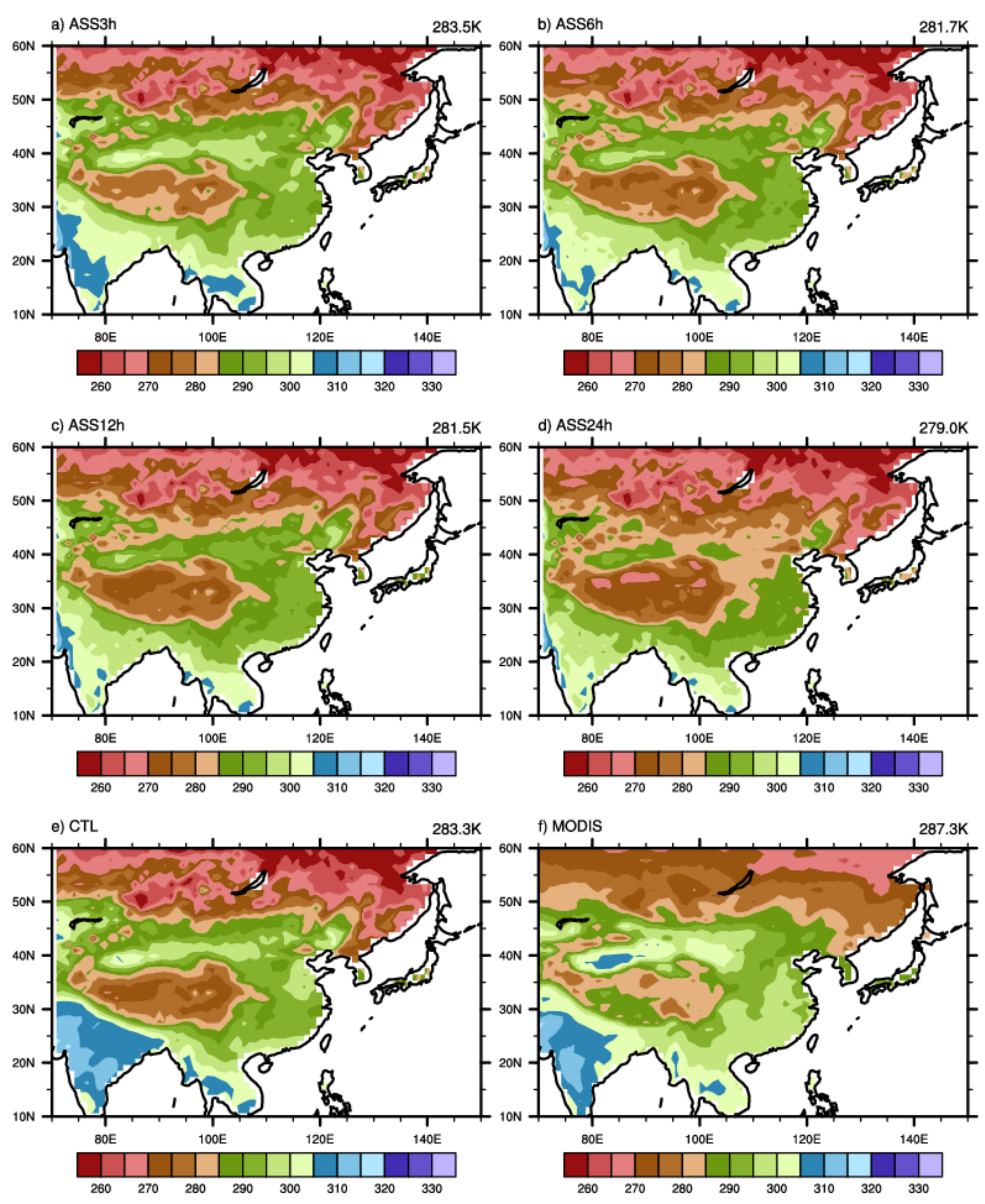
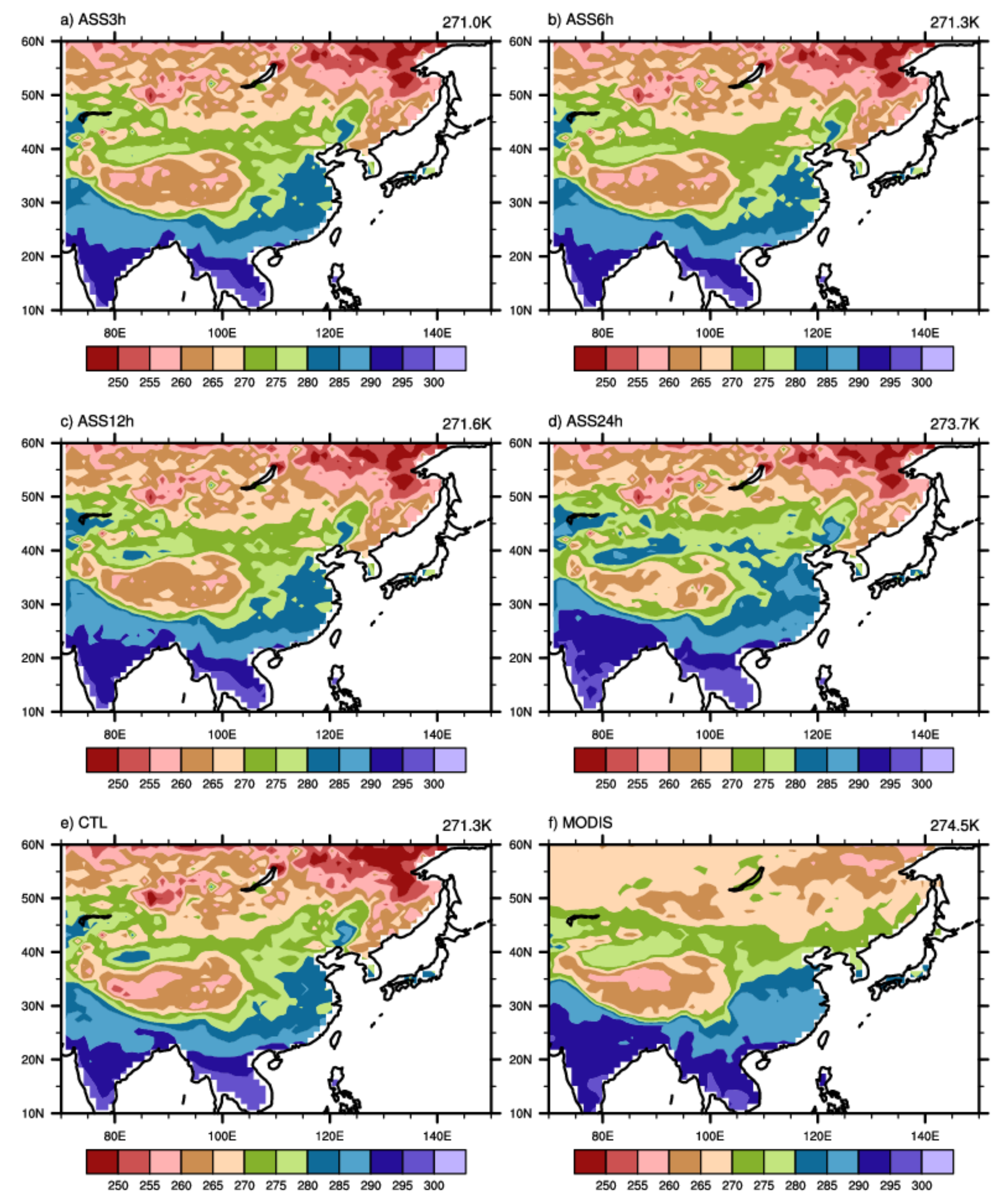

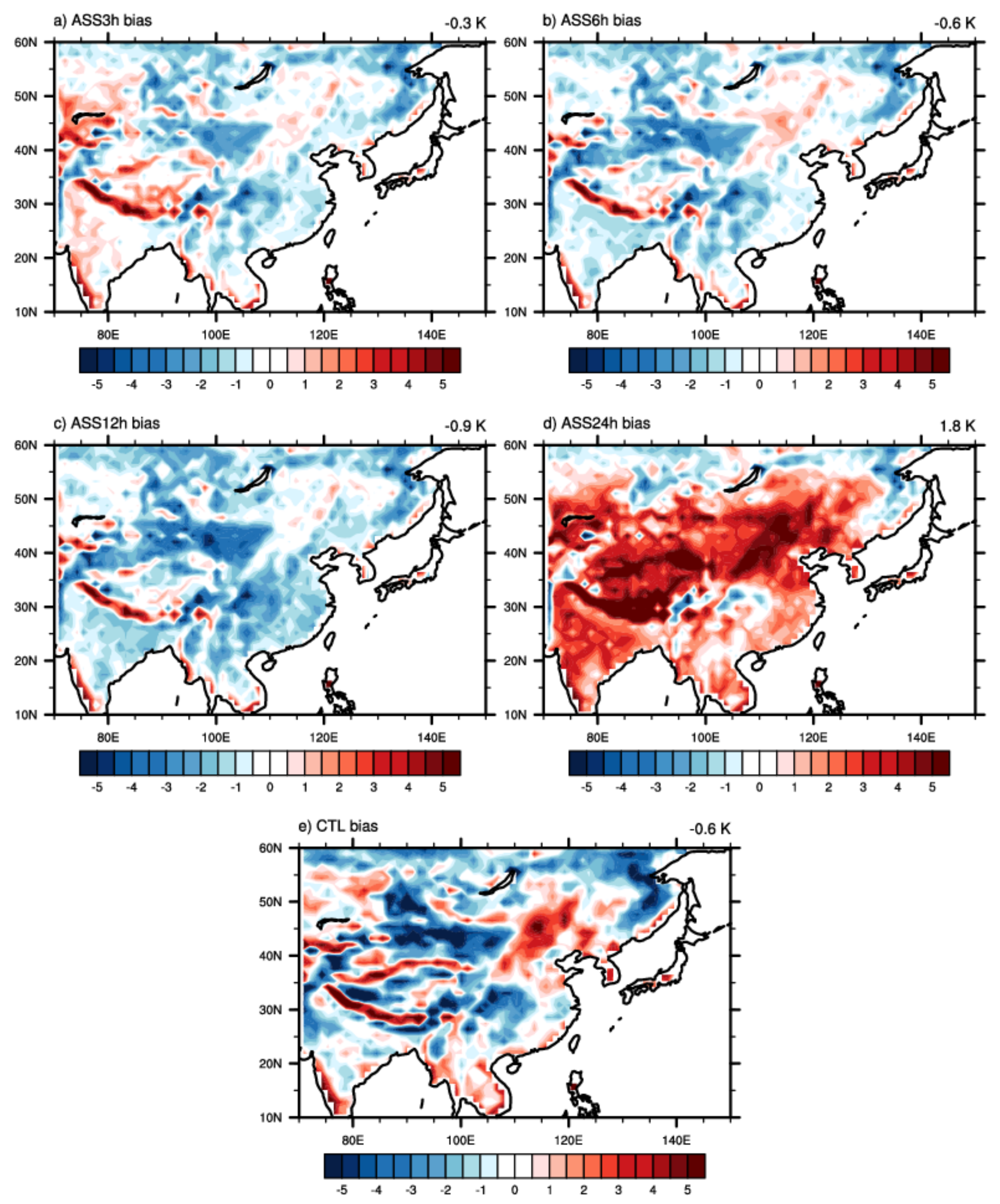
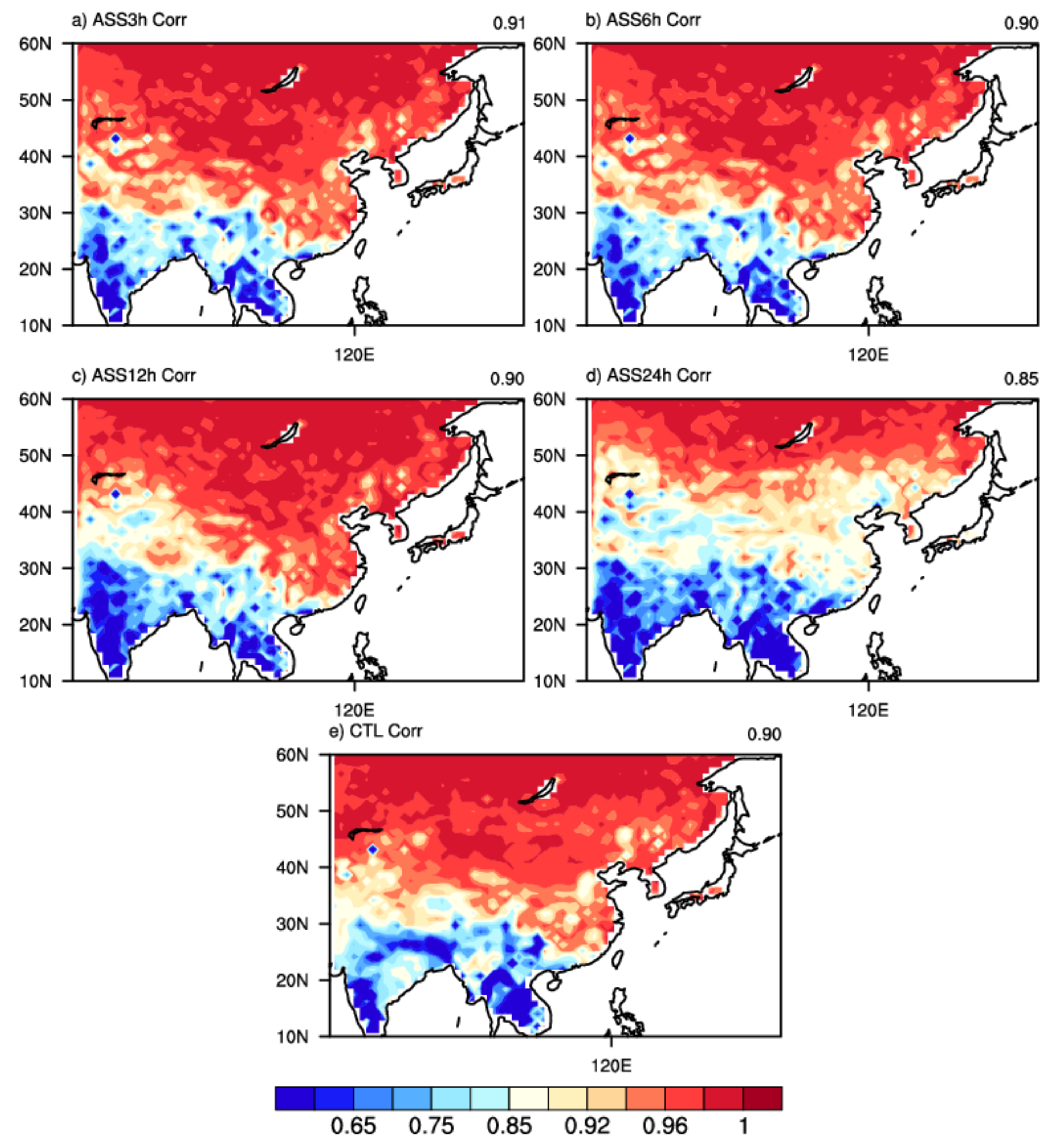

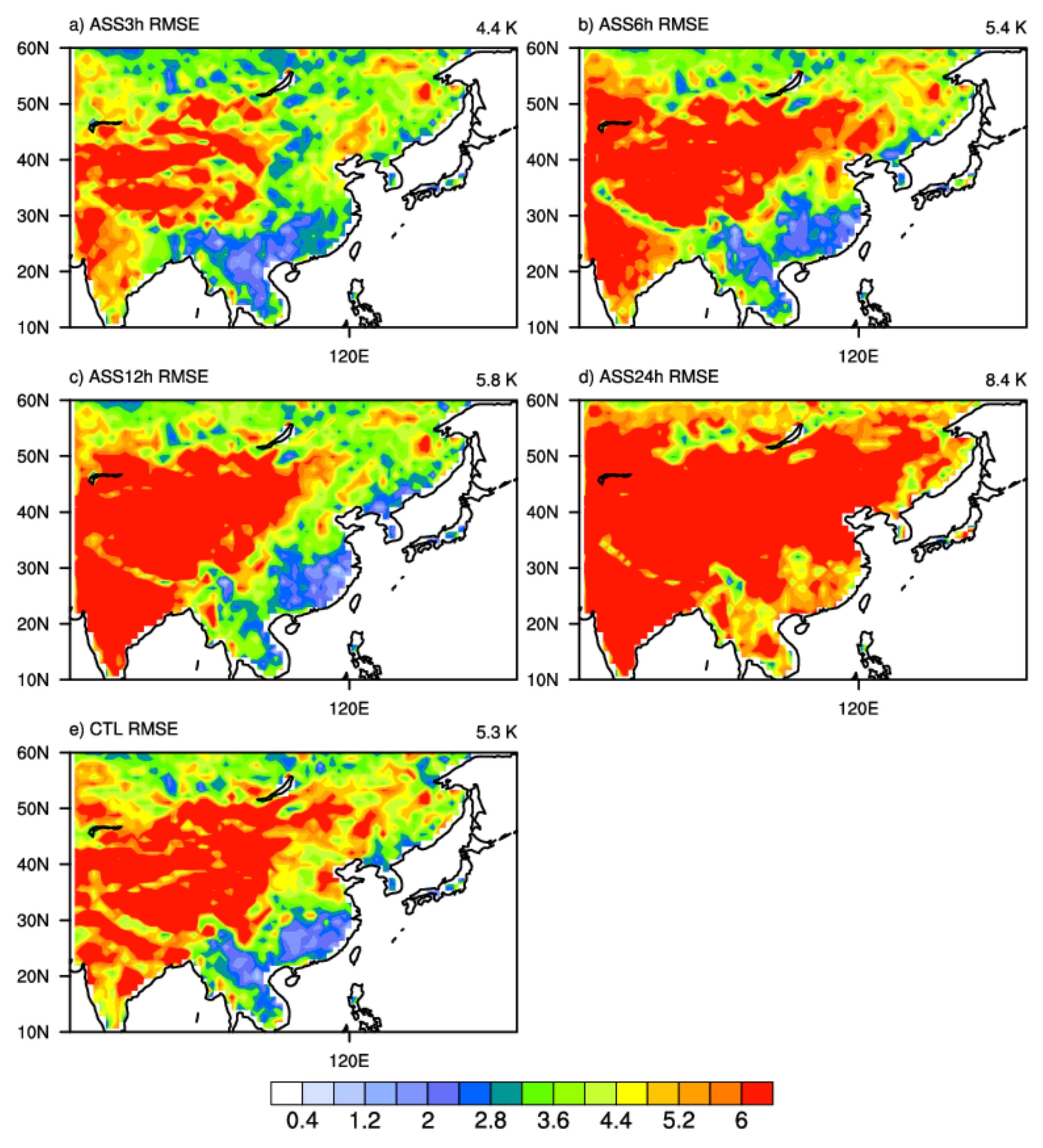
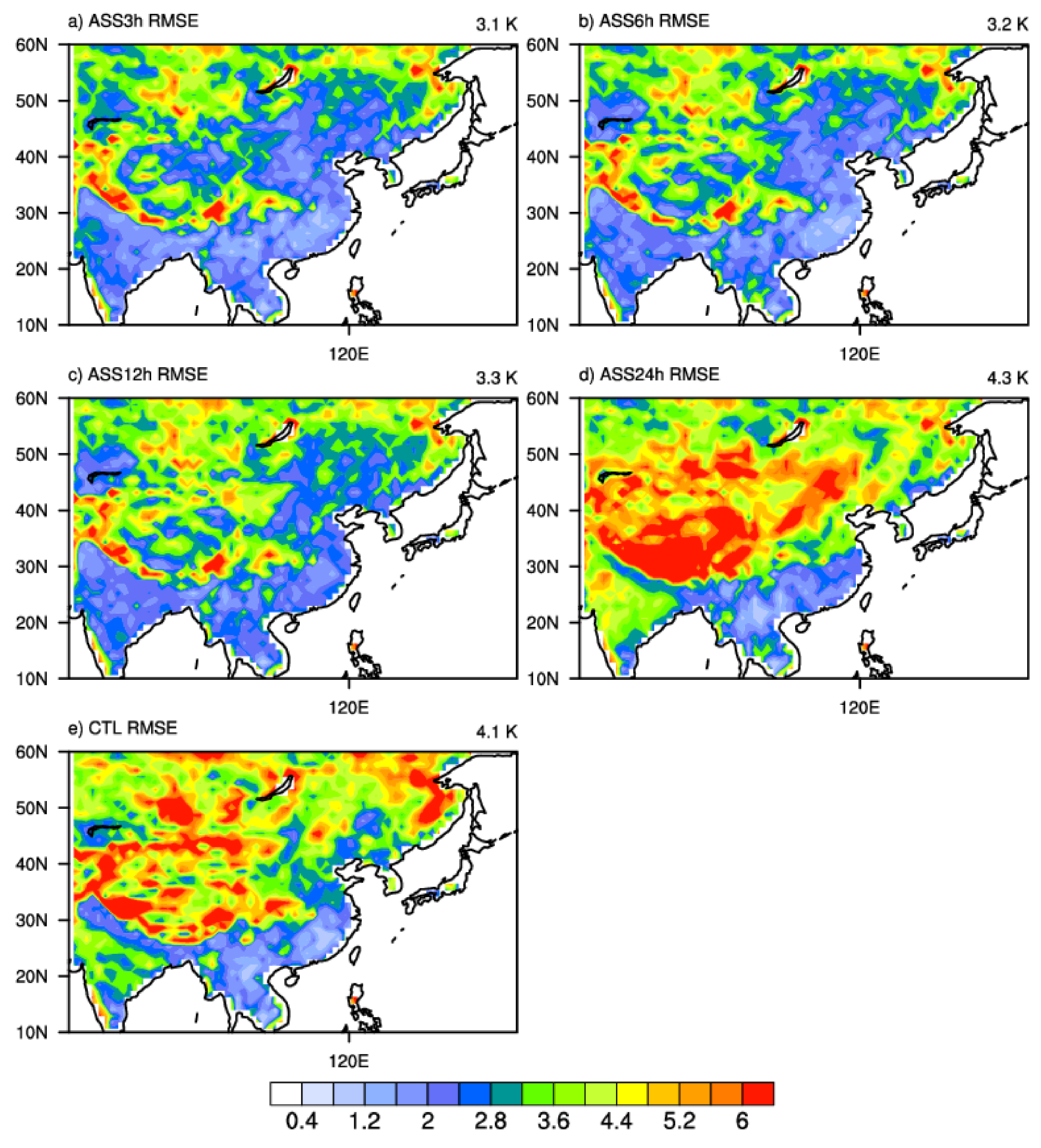

Disclaimer/Publisher’s Note: The statements, opinions and data contained in all publications are solely those of the individual author(s) and contributor(s) and not of MDPI and/or the editor(s). MDPI and/or the editor(s) disclaim responsibility for any injury to people or property resulting from any ideas, methods, instructions or products referred to in the content. |
© 2022 by the authors. Licensee MDPI, Basel, Switzerland. This article is an open access article distributed under the terms and conditions of the Creative Commons Attribution (CC BY) license (https://creativecommons.org/licenses/by/4.0/).
Share and Cite
Nie, S.; Jia, X.; Deng, W.; Lu, Y.; He, D.; Zhao, L.; Cao, W.; Deng, X. The Influence of FY-4A High-Frequency LST Data on Data Assimilation in a Climate Model. Remote Sens. 2023, 15, 59. https://doi.org/10.3390/rs15010059
Nie S, Jia X, Deng W, Lu Y, He D, Zhao L, Cao W, Deng X. The Influence of FY-4A High-Frequency LST Data on Data Assimilation in a Climate Model. Remote Sensing. 2023; 15(1):59. https://doi.org/10.3390/rs15010059
Chicago/Turabian StyleNie, Suping, Xiaolong Jia, Weitao Deng, Yixiong Lu, Dongyan He, Liang Zhao, Weihua Cao, and Xueliang Deng. 2023. "The Influence of FY-4A High-Frequency LST Data on Data Assimilation in a Climate Model" Remote Sensing 15, no. 1: 59. https://doi.org/10.3390/rs15010059
APA StyleNie, S., Jia, X., Deng, W., Lu, Y., He, D., Zhao, L., Cao, W., & Deng, X. (2023). The Influence of FY-4A High-Frequency LST Data on Data Assimilation in a Climate Model. Remote Sensing, 15(1), 59. https://doi.org/10.3390/rs15010059






